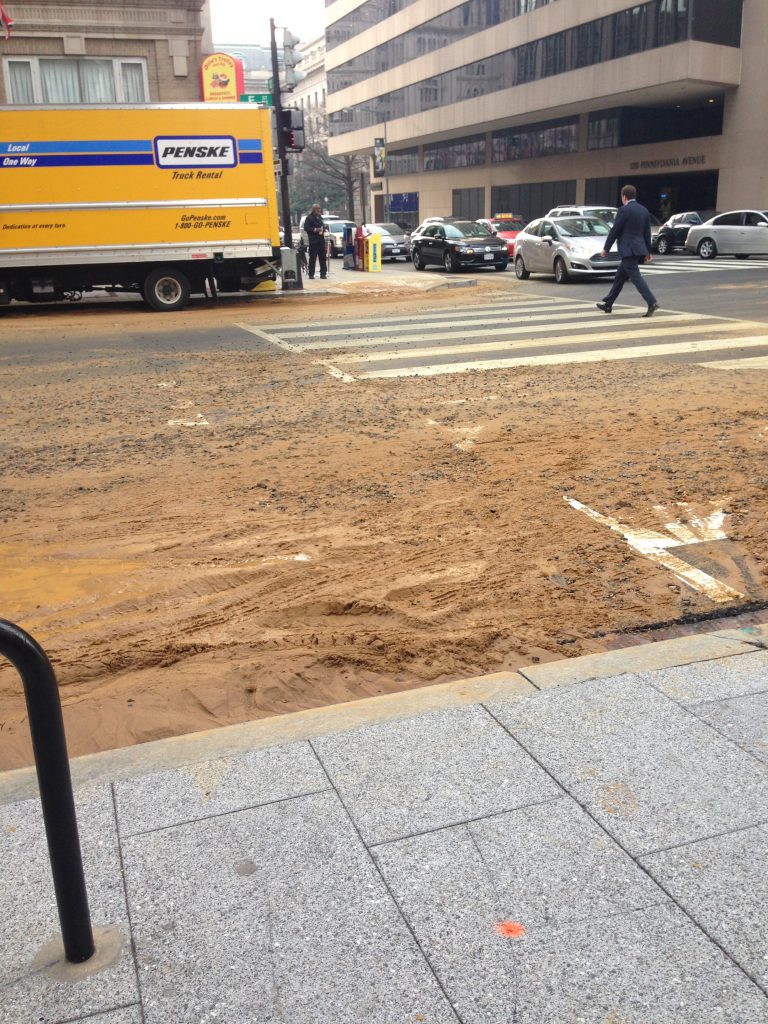
We talk a big game here at the Alliance for American Manufacturing about the need to invest in our nation’s infrastructure. But today, we weren’t just all talk — many of us dealt first hand with an infrastructure breakdown on our morning commute.
A water main burst early Tuesday morning at 12th and F Streets northwest in downtown Washington. Now, a water main break in a major corridor like this will no doubt create traffic nightmares under any circumstance. But this break was especially troublesome for D.C. commuters.
That’s because 12th and F Streets are situated right above the Metro Center station, a major transfer point for the D.C. region’s rail transit system. Four of the Metro’s six lines run through the station, including the Orange and Blue lines, which are among the busiest because they bring in commuters from the nearby Maryland and Virginia suburbs.
The station flooded soon after the break, and Metro officials had no choice but to suspend service to the station on the Orange, Blue and Silver lines and urge people to find another way to get to work. Nearby stations such as Federal Triangle also were closed due to flooding. Metro spokesman Dan Stessel told the Washington Post:
“Even if you don’t travel through this area, you will feel the effects of these delays. This is the morning to seek alternate travel options. We’re going to see major congestion from one end of these lines to the other and crowding at stations. There is no way to replicate the capacity and when you consider that it is rush hour and we have a water main break in the mix that’s why you see us out there saying consider other options.”
This photo shows water above the rail earlier this morning at Federal Triangle. All back to normal now. #wmata pic.twitter.com/yagjBI6wX3
— Metrorail Info (@Metrorailinfo) December 16, 2014
Finding other transportation options is easier said than done, of course. Roughly 750,000 ridership trips are taken on the Metro on an average workday.
Metro quickly deployed buses to shuttle riders between the impacted stations, but officials warned that they simply didn’t have enough buses to accommodate tens of thousands of stranded rail commuters.
Metro Center Water Main Break. Here are the lines waiting for buses at Farragut West Station. http://t.co/jEwVNRxPgb pic.twitter.com/MsXPxE2Dxw
— FOX 5 DC (@fox5newsdc) December 16, 2014
The Metro Center shutdown also impacted parts of the system away from downtown. Other lines quickly filled up with additional passengers. Our own Meghan Sullivan was forced to offload her Silver line train before even reaching D.C. because of overcrowding. Other commuters got off their very crowded trains when they reached city limits and walked the rest of the way to work.
And if you think driving into the city was the obvious solution … well, that wasn’t exactly the easy way out. Washington often rates the worst in the nation for traffic congestion, even beating out Los Angeles. Average drivers spend 67 hours and burn through 32 gallons of gas each year in traffic.
So when you add in a water main break right in the middle of the city’s downtown, well, those normal traffic woes turn into nightmares.
The Metro Center water main break truly highlights the importance of investing in our nation’s entire infrastructure system. The break (water pipeline infrastructure) impacted the city’s transit system (railway infrastructure) and caused traffic nightmares (roads and bridges infrastructure).
#watermainbreak in DC this morning. #metrocenter train station #closed pic.twitter.com/imhmlRx1zx
— Bill (@BillAlberterCNN) December 16, 2014
Tens of thousands of commuters arrived late to work today, resulting in lost productivity for businesses and organizations throughout the city. Sadly, this isn't an isolated event: Traffic congestion alone accounted for $200 billion in direct losses to the country’s economy in 2007, according to the Department of Transportation.
The good news for D.C. commuters? By quickly shutting off the water after the pipe burst and using pumps to get water off the tracks, Metro was able to restore service to the station sooner than expected. Streets around the area remained closed, however, and at least two nearby office buildings were without water as of 9 a.m. on Tuesday.
It remained unclear what caused the 61-year-old pipe to break. DC Water officials apologized for the “crazy commute” and pledged to make repairs as quickly as possible.
D.C. isn’t alone in dealing with such failures, of course. We’ve chronicled the water woes facing Southern California, and as The Value of Water pointed out on Twitter, a water main breaks every two minutes in the United States.
What today’s break really highlights is how interconnected our entire infrastructure system is. All of it needs investment, and the United States will continue to see ordeals like the one today in D.C. if we keep putting things off.
